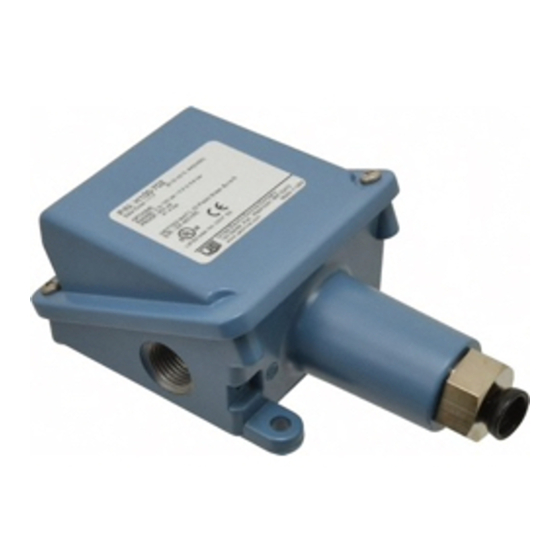Advertisement
Quick Links
Please read all instructional literature carefully and thoroughly before starting. Refer to the final page for the listing of Recommended
Practices, Liabilities and Warrantees.
GENERAL
Types B100 and C100 (Immersion Stem)
Temperature variations are sensed by a liquid filled sensor which expands
or contracts against a bellows which actuates a snap-action switch at a
predetermined set point.
Types E100 and F100 (Bulb & Capillary)
Temperature variations of a liquid filled sensing bulb are hydraulically
transmitted to a bellows which actuates a snap-acting switch at a
predetermined set point.
MaxiMuM TeMperaTure is The highesT TeMperaTure To
which a sensing eleMenT May be occasionally exposed To
wiThouT adversely affecTing seT poinT calibraTion and
repeaTabiliTy. MaxiMuM TeMperaTure liMiTs sTaTed in liTeraTure
and on naMeplaTe MusT never be exceeded, even by TeMperaTure
overshooTs in The sysTeM. occasional operaTion of uniT up
To Max. TeMperaTure is accepTable (e.g., sTarT-up, TesTing).
conTinuous operaTion should be resTricTed To The designaTed
adjusTable range.
Please refer to product bulletin for product specifications. Product
bulletins may be found at www.ueonline.com.
Part I - Installation
MouNTING
insTall uniT where shock, vibraTion and TeMperaTure
flucTuaTions are MiniMal. do noT MounT uniT in aMbienT
TeMperaTures exceeding published liMiTs. 100 series
TeMperaTure swiTches can be MounTed in any posiTion, provided
The elecTrical conduiT is noT facing up. orienT uniT so ThaT
MoisTure is prevenTed froM enTering The enclosure.
for remote mounting, mount the unit via the (2) 1/4" screw clearance holes
on the enclosure (see dimensions on back page.) fully immerse the bulb
and 6" capillary in the control zone. it is generally desirable to place the
bulb close to the heating or cooling source in order to sense temperature
fluctuations quickly. be sure to locate the bulb so that it will not be exposed
to temperatures beyond the instrument range limits.
for local MounTing, always hold a wrench on The
TeMperaTure housing hex when MounTing uniT. do noT
TighTen by Turning enclosure. This will daMage sensor
and weaken soldered or welded joinTs.
WIRING
disconnecT all supply circuiTs before wiring uniT.
elecTrical raTings sTaTed in liTeraTure and on naMeplaTe
MusT noT be exceeded. overload on a swiTch can cause
failure on The firsT cycle. wire uniTs according To naTional and
local elecTrical codes. MaxiMuM recoMMended wire size is 14 awg.
100 Series
Temperature Switch
Types B100, C100, E100, F100
Tools Needed
adjustable wrench
flathead screwdriver
hammer (for alternate wire knockouts)
remove the two screws retaining the cover and cover gasket. a 1/2" npT
conduit connection is located on the left side of the enclosure. Two cast-in
7/8" diameter knockouts for electrical conduit are located on the side and
rear of enclosure. These can easily be knocked out by placing the blade
of a screwdriver in the groove and tapping sharply with a hammer.
connect conduit to the enclosure and wire directly to the switch terminals
according to local and national electrical codes. bring the wires up to
terminals from the rear of the enclosure allowing enough slack so as not
to affect switch movement when making setting adjustments. The three
switch terminals are clearly labeled "common", "norm open", and "norm
closed". if lead wires are supplied, color coding is as follows:
common (coM)
normally open (no)
normally closed (nc)
a grounding screw and clamp (cast in symbol) is provided which meets a
35 lb. pull test. keep the wire as short as possible to prevent interference
with the plunger and, when provided, the adjustable deadband switch
wheel (option1519).
Part II - Adjustments
NoTE: for set point adjustments and recalibration, immerse sensor
(immersion stem or bulb and 6" of capillary) in a calibrated temperature
source and stabilize unit.
Types C100 and F100
remove cover. switch has a hex adjustment screw inside enclosure (see
figure 1). if switch transfer point differs from actual temperature, adjust
setting. To raise the temperature setting, turn the hex towards the left
(clockwise). To lower the temperature setting, turn the screw towards the
right (counter-clockwise). when making adjustments, do not exceed the
maximum temperature rating on nameplate.
Types B100 and E100 (with reference dial)
controls are factory calibrated for maximum accuracy at the midpoint of
the scale.
To re-calibrate, turn dial to desired set point(see figure 2). if the actual
temperature and set point temperature do not agree, turn hex adjustment
screw towards the left (clockwise) to raise and towards the right (counter-
clockwise) to lower temperature setting.
IMT100-04
U N I T E D E L E C T R I C
C O N T R O L S
Installation and Maintenance
Instructions
SPDT
violet
blue
black
3/16" open end wrench
IMT100-04
Tools Needed
Advertisement

Summary of Contents for United Electric Controls 100 Series
- Page 1 TeMperaTure flucTuaTions are MiniMal. do noT MounT uniT in aMbienT Tools Needed TeMperaTures exceeding published liMiTs. 100 series 3/16” open end wrench TeMperaTure swiTches can be MounTed in any posiTion, provided The elecTrical conduiT is noT facing up. orienT uniT so ThaT MoisTure is prevenTed froM enTering The enclosure.
- Page 2 C100, F100 RECOMMENDED PRACTICES AND WARNINGS United Electric Controls Company recommends careful consideration of the following factors when specifying and installing UE pressure and temperature units. Before installing a unit, the Installation COM. N.O. N.C. and Maintenance instructions provided with unit must be read and understood.







